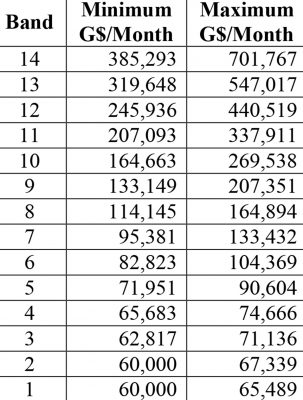Dear Editor,
Once more into the breach we keep falling. The evidence leading thereto, so far as compensation management in the public sector is concerned, cumulates to the conclusion that there is too little understanding by the relevant agencies of the basic principles to be observed in the formulation of salary structures, and the application of attendant normal periodic adjustments (increases). The situation becomes more frustrating when it comes to negotiating – between public employees and the representative employers.
In the brief period of months in 2018, there has been a display of none other than clumsy arrogance, in the following order:
the Ministry of Education and the Department of Labour towards the Guyana Teachers’ Union;
The University of Guyana towards:
UG Workers’ Union
UG Staff Association; and now
A Government Ministry towards the Guyana Public Service Union. The trend of imposition in respect of substantive salary increases is palpably the same. In the case of i) above an agreement of sorts was reached after industrial action, interspersed with the comedic appearance of a Conciliator. In respect of the rather academic display of human relations between the contending parties at ii), it was heartening to see that all employees concerned rejected the substantive disrespect shown to them.
At iii) comes the mimicry of a similar imposition of ‘graduated salary increases’ on public servants, with the GPSU being totally ignored.
Interestingly, included in approved Estimates of the National Assembly for the year 2018, as Appendix R(a), is the following Schedule of Salary in the Public Service (from 1st January, 2017)
It is therefore curious to learn, from SN of November 22, 2018 of the following construct:
“Government approved an increase for all public servants whose wages and salaries fall within the ranges herein stated as at December 31, 2017, with effect from January 1, 2018.
The increases ranged from 0 to 5% cent for the highest scale, that is $1 million and above, to seven percent on the lowest scale, that is up to $100,000. The 6.5% increase is for salaries ranging from $100,000 to $299,999; the 5% per cent increase is for $300,000 to $499,999; the 3% is for $500,000 to $699,999; the 2% is for $700,999 to $799,999, and the 1% is for $800,000 to $999,999.
These increases, the circular said, are payable to workers who are employed as at the November 2018 payroll and are applicable to all traditional public servants.”
What levels of public servants are being paid ‘$1m and above’?
Are they included in the category described as ‘traditional workers ’ whose scales are shown above?
If they are not then they must belong to the disproportionately large group of ‘Contracted Employees’.
If so, by what rationale do their specific contracts make them eligible for normal annual/periodic adjustments as do the ‘traditionals’, given the substantive disparities apparent in the abovementioned compensation structures. There is therefore reason to enquire whether or not reported new adjustments are applicable to both ‘traditionals’ and ‘millionaires’?
Basically ‘traditional’ employees are those on the pensionable establishment, while ‘Contracted Employees’ are offered gratuity every six months at the rate of 22.5% of monthly salary. It would therefore not be unreasonable for the former group to insist on enquiring whether their contracted counterparts benefit equivalently from the same adjustments proposed. (Colleague HR Managers are invited to comment on this apparent irrationality).
In this connection the approved 2018 Budget shows the following staffing numbers:
It needs to be clarified what numbers in the respective salary range qualify for the specified increases.
In this connection it may be relevant to refer once again to the consistently neglected recommendations of the familiar Report of the Commission of Inquiry into the Public Service. See the following.
“37) That Compensation Management be accepted as a key Human Resource Management function overseeing the full range of Compensation Management practices such as grading of jobs, and computation of salary structures.
38) That Public Service Management should be solely responsible for Wages and Salaries Administration in the Public Service. Therefore, the responsibilities undertaken by the Establishment Division of the Ministry of Finance relating to fixing salaries should be assigned to Public Service Management.
39) That the restructuring of the Public Service be undertaken in two phases. In the First Phase of the restructuring process, the Public Service Management should be responsible for conducting an audit of current employees’ pay arrangements and undertake the de-bunching exercise and adjust the current structure that will result in adjustment to the salaries of all employees.
40)That a small select group Human Resource Specialists comprise the Compensation Review and Advisory Committee. The Committee may consist of Permanent Secretaries, Heads of Departments and Public Service Management Staff objectives of the exercise and their individual and collective roles. It will also include the responsibility for analysis, evaluation, job structure development and the design of the Salary Structure.”
Most fundamental is that ignored by several administrations is the fact namely that no attempt has been made to review and revise the current job hierarchy established since the 1980s. This, in the face of the range of new technologies, methodologies and skills that are continually changing.
The following Job Hierarchy has remained defiantly the same over nearly four decades:
Administrative
Senior Technical
Other Technical and Craft-Skilled
Semi-skilled Operatives and Unskilled
to which the category of ‘Contracted Employees’ has been brazenly instituted over the latter two decades – remarkably bestriding all the above categories.
It is in recognition of this state of constipation that the COI also recommended as follows:
44) 1. Establish a Job Evaluation Committee that can be used to identify and select key jobs across the Public Service for a Salary Survey. This is particularly important since these jobs should represent jobs that are common across the Public Service with responsibilities and duties that are recognized and understood.”
It becomes useful to emphasise the very substantive point made by the appointed Commission of Inquiry that Compensation Management is a fundamental human resources management responsibility, and not a mere budget calculation by an unappreciative agency.
Urgent attention needs to be given to re-addressing this critical responsibility to the appropriately trained area of expertise.
Yours faithfully,
E.B. John











